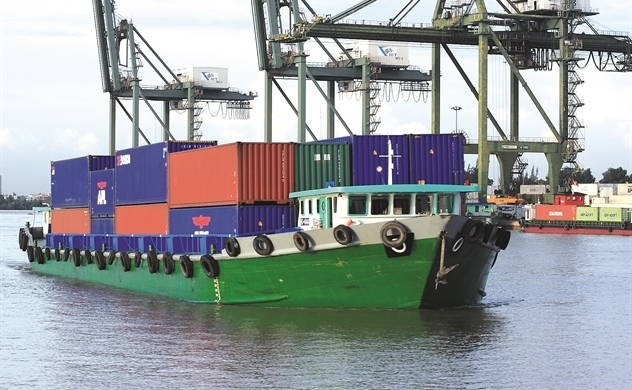According to Nguyen Dinh Viet, deputy director of the Vietnam Maritime Bureau (Vinamarine), the total volume of goods through Vietnam’s ports in the first half of the year reached 308.8 million tons, an increase of 13 percent compared with the same period last year. Of this, the volume of container goods was 9.1 million TEUs, an increase of 3 percent.

Meanwhile, the volume of goods through ports carried by the Vietnamese fleet was 81 million tons, up by 16 percent. This included 1.2 million TEU of container goods, up by 5 percent.
The fleet bearing the Vietnamese flag now undertakes nearly 100 percent of inland sea transport, except some specialized ships for carrying LPG and bulk cement. The goods for domestic transport are mostly household goods, food, coal, construction materials, machinery and equipment, containers, petroleum and general goods.
| It is expected that the volume of goods to go through Vietnam’s ports will grow by 12-16 percent annually, and by 2030, it will be 1.5-2 times higher than now. |
As for international shipping, the Vietnamese fleet holds about 7 percent of market share and mostly covers routes such as China, Japan, South Korea and Southeast Asia.
The Vietnamese container fleet mostly operates in short-distance routes in Southeast Asia and Northeast Asia, while some bulk carriers now run on routes to Europe.
As of June 2019, the Vietnamese sea fleet had 1,568 ships with the total capacity of 4.8 million GT, the total tonnage of 7.8 million DWT. The average age of the Vietnamese fleet is 15.6, younger than the world’s average of 20.8.
The Vietnamese fleet is developing towards specialization. Vietnam's container fleet has been growing, from 19 ships in 2013 to 39 ships in 2019. According to UNCTAD, the Vietnamese fleet ranks fourth in ASEAN and 30th in the world.
According to Le Cong Minh, chair of the Vietnam Ports Association, Vietnam has great potential for sea transport development. Vietnam has the long coastline of 3,200 kilometers and has 1 million square kilometers of waters capable for port development. It also has deep estuaries, airtight bays and international routes.
When building a port, if there is no need to build a breakwater, the investment cost is halved.
Also according to Minh, Laos and Cambodia, don’t have much access to the sea. Therefore, Vietnam’s ports could serve a whole region.
Regarding difficulties, analysts said the sailor shortage is the biggest problem. There are 40,000 sailors who have certificates in professional ability. However, according to Vinamarine, in 2018-2019, only 22,000 sailors registered to work on ships, which means that 43 percent of sailors are not employed in this field.
Mai Lan

Vietnam’s shipping fleet shrinks
The Vietnamese fleet continues to decline in quantity, raising concerns that the domestic cargo transportation strategy may not be completed.
 It is expected that the volume of goods to go through Vietnam’s ports will grow by 12-16 percent annually, and by 2030, it will be 1.5-2 times higher than now.
It is expected that the volume of goods to go through Vietnam’s ports will grow by 12-16 percent annually, and by 2030, it will be 1.5-2 times higher than now.